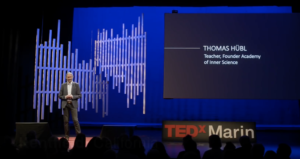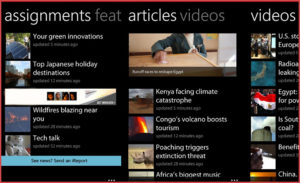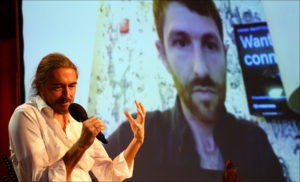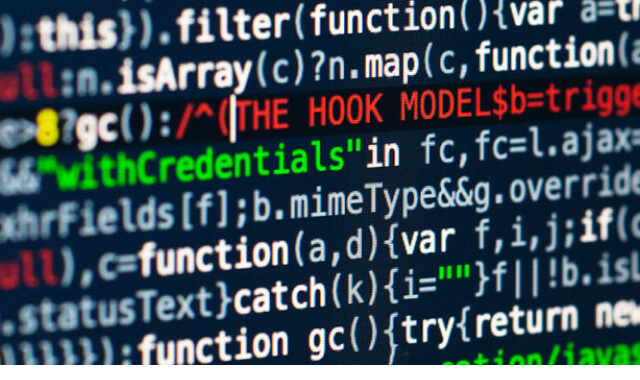Why is it important today to bring these issues together?
Today, technological development is progressing almost explosively. Digitization of the world of work, industry 4.0, robotization, artificial intelligence, and transhumanism (the link between man and machine) are some of the key words.
 On the one hand, every new development has the potential to contribute to the healing of trauma. On the other hand, new technologies can have an individual and societal trauma-enhancing effect by further exacerbating excessive demands, polarization, and fragmentation. And they can create new traumas, individually and collectively.
On the one hand, every new development has the potential to contribute to the healing of trauma. On the other hand, new technologies can have an individual and societal trauma-enhancing effect by further exacerbating excessive demands, polarization, and fragmentation. And they can create new traumas, individually and collectively.
We may be at a crossroads today. We as humanity are asked, individually and collectively, to make our contribution to the direction of technological development towards sustainability and humaneness, and not towards “human downgrading”, as Tristan Harris puts it. “Human downgrading” is the combined negative effects of digital technology on people and society.
Do we as humans use technology for our evolution and make it our partner — or are we dominated by technology?
Technological Development Makes Collective Trauma Visible
As a whole, the internet is a crucial evolution, and has opened up revolutionary new opportunities for communication. Thomas Hübl calls it the “external brain of mankind“. This development on the outside reflects an inner potential of the human being. The radius of the environment from which I can obtain information has completely detached itself from my geographical location, and extended to the whole world. New structures and networking possibilities that emerge on this basis come into tension and conflict with old, existing hierarchical structures, which also have to do with power concentration. This also makes patterns of collective trauma clearer.

Thomas Hübl, TEDxMarin Talk
Collective trauma is tendentially invisible. If it is particularly deep-set and long-lasting, and if it has been effective for several generations, it has formed cultural and social structures into which we are born. Our environment, shaped in this way, then seems “normal” to us. The trauma is hidden, and often only perceptible and experienced through certain symptoms and effects.
Through increasing coherence, the development of this “external brain of humanity”, the internet, with its new and innovative ways of networking, collective trauma can now become more visible. Due to increasing coherence, the areas where incoherence dominates become perceptible. Increasing networking opens up the possibility that the isolated parts of the collective suddenly become more noticeable and appear. Cross- and swarm-networking structures challenge the old hierarchical structures and create the impression of being threatened. A higher degree of connection brings the unconnected into view. The more transparent flow of information detects the less transparent areas and institutions of society.
The Possibility of Retraumatization through New Technologies
The speed of data transmission increases continuously. Ever larger amounts of data are chasing faster and faster through the network. Is your body still synchronized with the amount of information your intellect consumes? More pressure on the nervous system is generated. The nervous system of a healthy person can process this pressure and transform it into development and evolution. But if there’s trauma, it has side effects: Dissociation, burnout, the feeling of overstraining, stress, fear, and disembodiment.
 Much of the content sent around the world by news feeds has traumatic content, and can have a retraumatizing effect if one is predisposed.
Much of the content sent around the world by news feeds has traumatic content, and can have a retraumatizing effect if one is predisposed.
The internet can become an addiction (online gaming addiction is now officially recognized as a disease, and internet addiction and mobile phone addiction are also described as diseases).
“Never before has it been so easy to run away from yourself.” — Thich Nhat Hanh (on new technologies)
The “Attention Economy” Docks to Trauma Symptoms
Tristan Harris was connected to the Celebrate Life Festival 2019 for a conversation with Thomas Hübl.

Thomas Hübl, Tristan Harris, CLF 2019
He has placed the concept of the “attention economy” at the centre of the discussion. The abundance of information in today’s information society creates a deficiency elsewhere: in the attention it needs to process the information. For companies whose business model is based on attracting the attention of their customers, this means that the increasingly scarce attention becomes a contested commodity.
Harris worked for several years as an ethics designer at Google, and was called the “conscience” of the company. He dealt with the moral responsibility of tech companies, and came to the conclusion that their business model is not to strengthen our intelligence, but to research and exploit our weaknesses for their own purposes — with serious consequences.
Teen suicide was declining before 2010 in the USA, and now has a rate of increase of 17 percent! Harris sees this in the context of the development of social media and its influence on young people.
After seeing no success at Google in his efforts to influence the company towards more ethical standards, he left the company and founded the “Center for Humane Technology”.
With 2.45 billion monthly active users as of the third quarter of 2019, Facebook is the biggest social network worldwide. This is more than the sphere of influence of Christianity. Although use is free of charge, companies like Facebook are classified as being worth billions. How come? Your data, and that of the many other users, make up this value. Data is the gold of the digital age, they say. A new market worth billions has emerged.
 And how do platforms like Facebook, Youtube, Instagram and Co. get data? By encouraging you to spend more and more time there. A hard fight for attention has broken out. To this end, research into which mechanisms are most successful is being carried out. What is the best way to outsmart the unconscious of the user, and use trigger points to attract attention?
And how do platforms like Facebook, Youtube, Instagram and Co. get data? By encouraging you to spend more and more time there. A hard fight for attention has broken out. To this end, research into which mechanisms are most successful is being carried out. What is the best way to outsmart the unconscious of the user, and use trigger points to attract attention?
The more trauma, the more docking points for manipulation and such attacks there are. These strategies benefit from the fact that many people think they are immune to manipulation.
“The platforms address a part of the human brain — also known as the reptilian brain — which is responsible for emotions, addictive behavior, and urges.” — Elayne Safir, Interface Designer
 It is also a matter of using sophisticated, highly manipulative techniques to convey certain, often political, information and bring it to specific target groups.
It is also a matter of using sophisticated, highly manipulative techniques to convey certain, often political, information and bring it to specific target groups.
“It’s kidnapping our consciousness,” Harris says. “Technology determines what two billion people think and believe every day.”
According to Harris, this has now become a major threat to democratic structures, elections and social cohesion. “The attention economy tears apart our common social fabric.”
What can each of us do to minimize the attacks on our attention?
 Realize you’re being manipulated
Realize you’re being manipulated- Become more conscious, and work on your shadow. The more conscious I am, the less receptive I am to the mechanisms that target my unconscious
- Less is more: Take a news message (from the newspaper, the app, or the internet) and contemplate it as a meditation. Observe what is happening in your body, your thoughts, and your feelings. (See Five-Minutes-a-Day Practice – below under Sources)
Tristan Harris’ mobile phone tips (to stop the stress simulation and minimize the influence on the nervous system)
- Switch the phone display to black and white (color, especially red, triggers)
- Set your phone to silent
- Disable all notifications generated by machine and algorithms, and only let through those that come from real people
 Go to the Internet via a VPN service (these Virtual Private Networks protect and anonymize your personal data).
Go to the Internet via a VPN service (these Virtual Private Networks protect and anonymize your personal data).
What we can do — as a society
First of all, it’s important to clearly identify the problems. What is needed is an undisguised look at human downgrading, the downgrading of the human aspect in the development of new technologies, which has been underway for some time, and at the cultural climate change that this has triggered.
As a society, we can:
- Promote cultural awakening and actively contribute to society
- Ensure that trauma knowledge flows into technological development
- Support the companies that do a better job with privacy
- Appeal to the moral responsibility of those people who work in Tech Companies
- Work towards developers committing themselves to helping people spend time “better” rather than taking more time with manipulative techniques
- Help new ethical standards to break through
Outlook

Tristan Harris
“The ultimate freedom is a free mind, and we need technology that’s on our team to help us live, feel, think, and act freely.” — Tristan Harris
“We envision a world where technology supports our shared well-being, sense-making, democracy, and ability to tackle complex global challenges.” — Center for Human Technology
“Through the World Wide Web, we have created an external manifestation of our inner architecture. We created a global brain. And because of the global brain, we now have a perspective, a new consciousness of humanity and the world. And because of that, I believe that the digital restoration is now possible. If we use technology to help us to integrate trauma, we have a very powerful partner. When we use technology and develop technology, at the same time we are trauma-informed, and we take this trauma factor into account, I believe we can literally restore the trauma in the world.

Thomas Hübl
And this means that we can navigate the digital age with awareness and relatedness. We can extend our capacity to relate when we write an email, when we send a text message, when we post on social media. That these people are not out there, but we really relate to them and feel them, as if they were in the room with us. And I believe this again creates the effect that the cyberspace becomes a warm, intimate, and related internet. So that technology becomes the extension of our capacity to relate, and because relation is the number-one factor in curing trauma, I believe that when technology is our partner, we cannot only integrate individual traumatization, but also our collective traumas in the world.” — Thomas Hübl
Ina Krause
_________________________________________
Sources:
Talk between Tristan Harris and Thomas Hübl
July 31, 2019, Celebebrate Life Festival in Germany
“Gegen die Macht des Reptiliengehirns” – Eike Kühl, ZEIT Magazine online, March 11, 2018
https://www.zeit.de/digital/internet/2018-03/sxsw-silicon-valley-technologie-facebook-abhaengigkeit-tristan-harris/komplettansicht
Video “The Trauma of Technology” – TED-Talk by Thomas Hübl
